A Balanced Introduction to Computer Science and Programming
David Reed
Creighton University
Copyright © 2004 by Prentice Hall
Chapter 6: The History of Computers
Where a calculator on the ENIAC is equipped with 18,000 vacuum tubes and
weighs
30 tons, computers in the future may have only 1,000 vacuum tubes and weigh
only 1
1/2
tons.
Popular Mechanics, 1949
Never trust a computer you can't lift.
Stan Mazor, 1970
If the automobile had followed the same development cycle as the computer,
a Rolls-Royce would today cost $100, get one million miles to the gallon,
and explode once a year, killing everyone inside.
Robert X. Cringely
Computers are such an integral part of our society that it is sometimes
difficult to imagine life without them. However, computers as we know them
are relatively new devices, with the first electronic computers dating back
to the 1940's. Since that time, technology has advanced at an astounding rate,
with the capacity and speed of computers approximately doubling every two years.
Today, pocket calculators have many times the memory capacity and processing
power of the mammoth computers of the 1950's and 1960's.
This chapter presents an overview of the history of computers and computer
technology. The history of computers can be divided into generations, roughly
defined by technological advances that led to improvements in design,
efficiency, and ease of use.
Generation 0: Mechanical Computers (1642-1945)
 Pascal's calculator
Pascal's calculator
|
The first working calculating machine was invented in 1623 by German inventor
Wilhelm Schickard (1592-1635), although details of its design were lost in a
fire soon after its construction. In 1642, the French scientist Blaise Pascal
(1623-1635) built a mechanical calculator when he was only 19. His machine
used mechanical gears and was powered by hand. A person could enter numbers
up to eight digits long using dials and then turn a crank to either add or
subtract. Thirty years later, the German mathematician Gottfried Wilhelm von
Leibniz (1646-1716) generalized the work of Pascal to build a mechanical
calculator that could also multiply and divide. A variation of Leibniz's
calculator, built by Thomas de Colmar (1785-1870) in 1820, was widely used
throughout the 19th century.
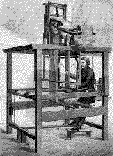 Jacquard's loom
Jacquard's loom
|
While mechanical calculators grew in popularity in the early 1800's, the first
programmable machine built was not a calculator at all, but a loom. Around 1801,
Frenchman Joseph-Marie Jacquard (1752-1834) invented a programmable loom that
used removable punched cards to represent patterns. Before Jacquard's loom,
producing tapestries was complex and tedious work. In order to produce a
pattern, different colored threads (called wefts) had to be woven over and
under the cross-threads (called warps) to produce the desired effect. Jacquard
devised a way of encoding the patterns of the threads using metal cards with
holes punched in them. When a card was fed through the machine, hooks passed
through the holes to selectively raise warp threads, and so produce the
desired over-and-under pattern. The result was that complex brocades could
be encoded using the cards, and then reproduced exactly. Simply by changing
the cards, the same loom could be used to automatically weave different patterns.
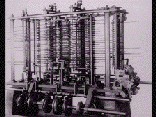 Babbage's Difference Engine
Babbage's Difference Engine
|
The idea of using punched cards for storing data was adopted in the mid 1800's
by the English mathematician Charles Babbage (1791-1871). In 1821, he proposed
the design of his Difference Engine, a steam-powered mechanical calculator for
finding the solutions to polynomial equations. Although a fully functional
model was never completed due to limitations in 19th century manufacturing
technology, a prototype that punched output onto copper plates was built and
used in computing data for naval navigation. Babbage's work with the Difference
Engine led to his design in 1833 of a more powerful machine that included many
of the features of modern computers. His Analytical Engine was to be a
general-purpose, programmable computer that accepted input via punched cards
and printed its output on paper. Similar to the design of modern computers,
the Analytical Engine was to be made of integrated components, including a
readable/writeable memory for storing data and programs (which Babbage called
the store), and a control unit for fetching and executing instructions (which
he called the mill). Although a working model of the Analytical Engine was
never completed, its innovative and visionary design was popularized by the
writings and patronage of Augusta Ada Byron, Countess of Lovelace (1815-1852).
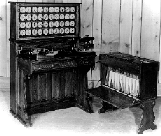 Hollerith's machine
Hollerith's machine
|
Punch cards resurfaced in the late 1800's in the form of Herman Hollerith's
tabulating machine. Hollerith invented a machine for sorting and tabulating
data for the 1890 U.S. Census. His machine utilized punch cards to represent
census data, with specific holes on the cards representing specific information
(such as male/female, age, home state, etc.) Recall that in Jacquard's loom,
the holes in punch cards allowed hooks to selectively pass through and raise
waft threads. In the case of Hollerith's tabulating machine, metal pegs
passed through holes in the cards, making an electrical connection with a
plate below that could be sensed by the machine. By specifying the desired
pattern of holes, the machine could sort or count all of the cards
corresponding to people with given characteristics (such as all men, aged
30-40, from Maryland). Using Hollerith's tabulating machine, the 1890 census
was completed in six weeks (compared to the 7 years required for the 1880
census). Hollerith founded the Tabulating Machine Company in 1896 to market
his machine. Eventually, under the leadership of Thomas J. Watson, Sr.,
Hollerith's company would become known as International Business Machines (IBM).
 electromagnetic relay
electromagnetic relay
|
It wasn't until the 1930's and the advent of electromagnetic relays that
computer technology really started to develop. An electromagnetic relay is
a mechanical switch that can be opened and closed by an electrical current
that magnetizes it. The German engineer Konrad Zuse (1910-1995) is credited
with building the first computer using relays in the late 1930's. However,
his work was classified by the German government and eventually destroyed
during World War II, and so did not influence other researchers. In the late
1930's, John Atanasoff (1903-1995) at Iowa State and George Stibitz (1904-1995)
at Bell Labs independently designed and built automatic calculators using
electromagnetic relays. In the early 1940's, Howard Aiken (1900-1973) at
Harvard rediscovered the work of Babbage and began applying some of Babbage's
ideas to modern technology. Aiken's Mark I, built in 1944, may be seen as an
implementation of Babbage's Analytical Engine using relays.
In comparison with modern computers, the speed and computational power of
these early computers may seem primitive. For example, the Mark I computer
could store only 72 numbers in memory, although it could store an additional
60 constants through manual switches. The machine could perform 10 additions
per second, but required up to 6 seconds to perform a multiplication and 12
seconds to perform a division. Still, it was estimated that complex calculations
could be completed 100 times faster using the Mark I as opposed to existing
technology at the time.
Generation 1: Vacuum Tubes (1945-1954)
 vacuum tubes
vacuum tubes
|
While electromagnetic relays were certainly much faster than wheels and gears,
they still required the opening and closing of mechanical switches. Thus,
computing speed was limited by the inertia of moving parts. Relays also tended
to be cumbersome and had a tendency to jam. A classic example of this is an
incident involving the Harvard Mark II (1947), in which a computer failure was
eventually traced to a moth that had become wedged between relay contacts.
Grace Murray-Hopper (1906-1992), who was on Aiken's staff at the time, taped
the moth into the computer logbook and facetiously noted the "First actual
case of bug being found."
In the mid 1940's, electromagnetic relays began to be replaced by vacuum
tubes, resulting in machines whose only moving parts were electrons. Invented
by Lee de Forest (1873-1961) in 1906, a vacuum tube is a small glass tube
from which all or most of the gas has been removed, permitting electrons to
move with minimal interference from gas molecules. Since vacuum tubes have no
moving parts (only the electrons move), they permitted the switching of
electrical signals at speeds far exceeding those of any mechanical device.
In fact, vacuum tubes were up to 1,000 times faster than electromagnetic
relays. They could also be used to construct fast storage devices.
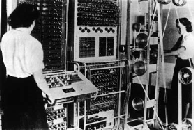 COLOSSUS
COLOSSUS
|
The stimulus for the electronic (vacuum tube) computer was World War II. The
first electronic computer was COLOSSUS, built by British government to decode
encrypted Nazi communications. COLOSSUS was designed in part by the British
mathematician Alan Turing (1912-1954), who is considered one of the founding
fathers of computer science due to his seminal work in the theory of
computability and artificial intelligence. While operational in 1943,
COLOSSUS's influence over other researchers at the time was limited as its
existence remained classified for over 30 years. It contained more than 2,300
vacuum tubes, and had a unique design due to its intended purpose as a
code-breaker. It contained 5 different processing units, each of which could
read in and process 5,000 characters of code per second. Using COLOSSUS,
British Intelligence was able to decode Nazi military communications for
extended periods, providing invaluable support to Allied operations during the war.
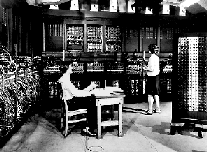 ENIAC
ENIAC
|
At roughly the same time in the United States, physics professor John
Mauchly (1907-1980) and his graduate student J. Presper Eckert (1919-1995)
designed ENIAC, which was an acronym for Electronic Numerical Integrator And
Computer. The ENIAC was designed to compute ballistics tables for the U.S. Army,
but it was not completed until 1946. It consisted of 18,000 vacuum tubes and
1500 relays, weighed 30 tons, and consumed 140 kilowatts of power. In contrast
to the Mark I, the ENIAC could only store 20 numbers in memory, although more
than 100 constants could be entered using switches. Still, the ENIAC could
perform more complex calculations than the Mark I and operated up to 500 times
faster (5,000 additions per second). The ENIAC was programmable in that it
could be reconfigured to perform different computations. However, reprogramming
the machine required manually setting up to 6,000 multiposition switches and
reconnecting cables. In a sense, it was not so much reprogrammed as it was
rewired each time the application changed.
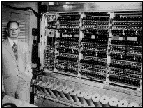 John von Neumann
John von Neumann
|
One of the scientists involved in the ENIAC project was John von Neumann
(1903-1957), who along with Turing is considered a founding father of the
field of computer science. Von Neumann recognized that programming via switches
and cables was tedious and error prone. As an alternative, he designed a
computer architecture in which the program could be stored in memory along
with the data. Although this idea was initially proposed by Babbage with his
Analytical Engine, von Neumann is credited with its formalization using modern
designs. Von Neumann also recognized the advantages of using binary (base 2)
representation in memory as opposed to decimal (base 10), which had been used
previously. His basic design was used in EDVAC (Eckert and Mauchly at UPenn,
1952), IAS (von Neumann at Princeton, 1952), and subsequent machines. The von
Neumann architecture is still the basis for nearly all modern computers.
As a result of von Neumann's "stored program" architecture, the process of
programming a computer became equally if not more important than designing a
computer. Before von Neumann, computers were not so much programmed as they
were hard-wired to a particular task. With the von Neumann architecture, a
program could be read in (via cards or tapes) and stored in the memory of the
computer. Reprogramming the computer did not require any reconfiguring, it
simply involved reading in and storing a new program for execution. At first,
programs were written in machine language, sequences of 0's and 1's that
corresponded to instructions directly executable by the hardware. While this
was an improvement over rewiring, it still required the programmer to write
and manipulate pages of binary numbers -- a formidable and error-prone task.
In the early 1950s, assembly languages were invented which simplified the
programmer's task somewhat by substituting simple mnemonic names for binary numbers.
The early 1950's also marked the birth of the commercial computer industry.
Eckert and Mauchly left the University of Pennsylvania to form their own company.
In 1951, The Eckert-Mauchly Computer Corporation (later a part of Remington-Rand,
then Sperry-Rand) began selling the UNIVAC I computer. The first UNIVAC I was
purchased by the U.S. Census Bureau, and a subsequent UNIVAC I captured the
public imagination when it was used by CBS to predict the 1952 presidential
election. Several other companies would soon follow Eckert-Mauchly with
commercial computers. It is interesting to note that at this time,
International Business Machines (IBM) was a small company producing card punches
and mechanical card sorting machines. It entered the computer industry late in
1953, and did not really begin its rise to prominence until the early 1960's.
Generation 2: Transistors (1954-1963)
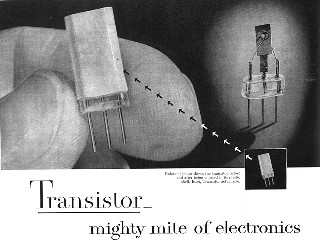 RCA transistor ad from Fortune
1953/3
RCA transistor ad from Fortune
1953/3
|
Vacuum tubes, in addition to being relatively large (several inches long),
dissipated an enormous amount of heat. Thus, they required lots of space for
cooling and tended to burn out frequently. The next improvement in computer
technology was the replacement of vacuum tubes with transistors. Invented by
John Bardeen, Walter Brattain, and William Shockley in 1948, a transistor is a
piece of silicon whose conductivity can be turned on and off using an electric
current. Transistors were much smaller, cheaper, more reliable, and more
energy-efficient than vacuum tubes. As such, they allowed for the design of
smaller and faster machines at drastically lower cost.
Transistors may be the most important technological development of the 20th
century. They allowed for the development of small and affordable electronic
devices: radios, televisions, phones, computers, etc., as well as the
information-based economy that developed along with them. The potential impact
of transistors was recognized almost immediately, earning Bardeen, Brattain,
and Shockley the 1956 Nobel Prize in physics. The first transistorized computers
were supercomputers commissioned by the Atomic Energy Commission for nuclear
research in 1956: Sperry-Rand's LARC and IBM's STRETCH. Companies such as IBM,
Sperry-Rand, and Digital Equipment Corporation (DEC) began marketing
transistor-based computers in the early 1960's, with the DEC PDP-1 and IBM
1400 series being especially popular.
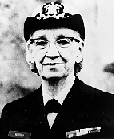 Rear Admiral Grace Murray-Hopper
Rear Admiral Grace Murray-Hopper
|
As transistors drastically reduced the cost of computers, even more attention
was placed on programming. If computers were to be used by more than just the
engineering experts, programming would have to become simpler. In 1957, John
Backus (1924-) and his group at IBM introduced the first high-level programming
language, FORTRAN (FORmula TRANslator). This language allowed the programmer to
work at a higher level of abstraction, programming via mathematical formulas as
opposed to assembly level instructions. Programming in a high-level language
like FORTRAN greatly simplified the task of programming, although IBM's original
claims that FORTRAN would "eliminate coding errors and the debugging process"
were a bit optimistic. Other high-level languages were developed in this
period, including LISP (John McCarthy at MIT, 1959), BASIC (John Kemeny at
Dartmouth, 1959), and COBOL (Grace Murray-Hopper at the Department of
Defense, 1960).
The 1960's saw the rise of the computer industry, with IBM becoming a major
force. The success of IBM is not so much attributed to superior technology, but
more to its shrewd business sense and effective long-range planning. While
smaller companies like DEC, CDC, and Burroughs may have had more advanced
machines, IBM won market share through aggressive marketing, reliable customer
support, and a strategy of designing an entire family of compatible,
interchangeable machines.
Generation 3: Integrated Circuits (1963-1973)
 integrated circuits
integrated circuits
|
Transistors were far superior to the vacuum tubes they replaced in many ways:
they were smaller, cheaper to mass produce, and more energy-efficient. However,
early transistors still generated a great deal of heat, which could damage
other components inside the computer. In 1958, Jack Kilby (1923-) at Texas
Instruments developed a technique for manufacturing transistors as layers of
conductive material on a silicon disc. This new form of transistor could be
made much smaller than existing, free-standing transistors, and also generated
less heat. Thus, tens or even hundreds of transistors could be layered onto the
same disc and connected with conductive layers to form simple circuits. Such a
disc, packaged in metal or plastic with external pins for connecting with other
components, is known as an Integrated Circuit (IC) or IC chip. Packaging
transistors and related circuitry on an IC that could be mass-produced made
it possible to build computers that were smaller, faster, and cheaper. A
complete computer system could be constructed by mounting a set of IC chips
(and other support devices) on circuit boards and soldering them together.
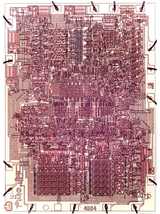 Intel 4004
Intel 4004
|
As manufacturing technology improved, the number of transistors that could be
fit on a single chip increased. In 1965, Gordon Moore (1929-) noticed that the
number of transistors that could fit on a chip roughly doubled every 12 to 18
months. This trend became known as Moore's Law, and has continued to be an
accurate predictor of technological advances. By the 1970's, the Large Scale
Integration (LSI) of thousands of transistors on a single IC chip became
possible. In 1971, the Intel Corporation made the logical step of combining
all of the control circuitry for a calculator into a single chip called a
microprocessor. The Intel 4004 microprocessor contained more than 2,300
transistors. Its descendant, the 8080, which was released in 1974, contained
6,000 transistors and was the first general-purpose microprocessor, meaning
that it could be programmed to serve various functions. The Intel 8080 and
its successors, the 8086 and 8088 chips, served as central processing units
for numerous personal computers in the 1970's, including the IBM PC. Other
semiconductor vendors such as Texas Instruments, National Semiconductors,
Fairchild Semiconductors, and Motorola also produced microprocessors in the 1970's.
As was the case with previous technological advances, the development of
integrated circuits led to faster and cheaper computers. Whereas computers in
the early 1960's were affordable only for large corporations, IC technology
rapidly brought down costs to the level where small businesses could afford
them. As such, more and more people needed to be able to interact with computers.
A key to making computers easier for non-technical users was the development of
operating systems, master control programs that oversee the operation of the
computer and manage peripheral devices. An operating system acts as an interface
between the user and the physical components of the computer, and through a
technique known as time-sharing, can even allow multiple users to share the same
computer simultaneously. In addition to operating systems, specialized
programming languages were developed to fill the needs of the broader base
of users. In 1971, Niklaus Wirth (1934-) developed Pascal, a simple language
designed primarily for teaching but which has dedicated users to this day.
In 1972, Dennis Ritchie (1941-) developed C, a systems language used in the
development of the UNIX operating system. Partly because of the success of UNIX,
C and its descendant C++ have become the industry standards for systems
programming and software engineering.
Generation 4: VLSI (1973-1985)
| Year | Processor | # Transistors
|
| 2000 | Pentium 4 | 42,000,000
|
| 1999 | Pentium III | 9,500,000
|
| 1997 | Pentium II | 7,500,000
|
| 1993 | Pentium | 3,100,000
|
| 1989 | 80486 | 1,200,000
|
| 1985 | 80386 | 275,000
|
| 1982 | 80286 | 134,000
|
| 1978 | 8088 | 29,000
|
| 1974 | 8080 | 6,000
|
| 1972 | 8008 | 3,500
|
| 1971 | 4004 | 2,300
Intel Family of IC Chips
|
While the previous generations of computers were defined by new technologies,
the jump from generation 3 to generation 4 is largely based upon scale. By the
mid 1970's, advances in manufacturing technology led to the Very Large Scale
Integration (VLSI) of hundreds of thousands and eventually millions of
transistors on an IC chip. As an example of this, consider the table to the
left that shows the number of transistors on chips in the Intel family. It is
interesting to note that the first microprocessor, the 4004, had approximately
the same number of switching devices (transistors) as the COLOSSUS, which
utilized vacuum tubes in 1943. Throughout the 1970's and 1980's, successive
generations of IC chips added more and more transistors, providing more
complex functionality in the same amount of space. It is astounding to note
that the Pentium 4, which was released in 2000, has more than 42 million
transistors, with individual transistors as small as 0.18 microns
(0.00000000018 meters).
As the mass production of microprocessor chips became possible in the 1970's
with VLSI, the cost of computers dropped to the point where a single individual
could afford one. The first personal computer (PC), the MITS Altair 8800, was
marketed in 1975 for under $500. In reality, the Altair was a computer kit that
included all of the necessary electronic components, including the 8080
microprocessor that served as the central processing unit for the machine.
The customer was responsible for wiring and soldering all of these components
together to assemble the computer. Once assembled, the Altair had no keyboard,
no monitor, and no permanent storage. The user entered instructions directly by
flipping switches on the console, and viewed output as blinking lights. Despite
these limitations, demand for the Altair was overwhelming.
 Jobs & Wozniak
Jobs & Wozniak
|
While the company that sold the Altair, MITS, would fold within a few years,
other small computer companies successfully charted the PC market in the late
1970's. In 1976, Steven Jobs (1955-) and Stephen Wozniak (1950-) got their
start selling computer kits similar to the Altair, which they called the Apple.
In 1977, they founded Apple Computer and began marketing the Apple II, the first
pre-assembled personal computer with a keyboard, color monitor, sound, and
graphics. By 1980, the annual sales of their Apple II personal computer had
reached almost $120 million. Other companies, such as Tandy, Amiga, and
Commodore soon entered the market with personal computers of their own.
IBM, which had been slow to enter the personal computer market, introduced the
IBM PC in 1980, becoming an immediate force. Apple countered with the Macintosh
in 1984, which introduced the now familiar graphical user interface of windows,
icons, and a mouse.
 Bill Gates
Bill Gates
|
As computers became the tools of more and more individuals, the software
industry grew and adapted. Bill Gates (1955-) is credited with writing the
first commercial software for personal computers, a BASIC interpreter for the
Altair. In 1975, while a freshman at Harvard, he cofounded Microsoft along with
Paul Allen (1955-) and helped to build that company into the software giant
that it is today. Much of Microsoft's initial success was due to its marketing
of the MS-DOS operating system for PCs, and applications programs such as word
processors and spreadsheets. By the mid 1990's, Microsoft Windows had become
the dominant operating system for desktop computers, and Bill Gates, in his
early 40's, had become the richest person in the world.
The proliferation of programming languages continued in the 1980's and
beyond. In 1980, Alan Kay (1940-) developed Smalltalk, the first object-oriented
language. Ada was developed for the Department of Defense in 1980, to be used
for all government contracts. In 1985, Bjarne Stroustrup (1950-) developed C++,
an object-oriented extension of C. C++ and its offshoot Java (developed in 1995
at Sun Microsystems) have become the dominant languages in software engineering
today.
Generation 5: Parallel Processing & Networking (1985-????)
 Deep Blue defeats Kasparov
Deep Blue defeats Kasparov
|
While generations 0 through 4 are reasonably well-defined, the scope of the
fifth generation of computer technology is still an issue of debate. What is
clear is that computing in the late 1980's and beyond has been defined by
advances in parallel processing and networking. Parallel processing refers
to the integration of multiple (sometimes hundreds or thousands) processors
in a computer. By sharing the computational load across multiple processors,
a parallel computer is able to execute programs in only a fraction of the time
required by a single processor computer. A striking example of this is IBM's
Deep Blue, a parallel processing computer specifically designed for playing
chess. Using 256 processors, Deep Blue is able to evaluate millions of potential
moves in a second and thus select the most promising move. In 1997, Deep Blue
became the first computer to defeat the reigning world's chess champion in
tournament play.
Up until the 1990's, most computers were stand-alone devices. Small-scale
networks of computers were common in large businesses, but communication
between networks was rare. The idea of a large-scale network, connecting
computers from remote sites, traces back to the 1960's. The ARPAnet,
connecting four computers in California and Utah, was founded in 1969.
However, its use was mainly limited to government and academic researchers.
As such, the ARPAnet, or Internet as it would later be called, grew at a slow
but steady pace. That changed in the 1990's with the development of the World
Wide Web. The Web, a multimedia environment in which documents can be
seamlessly linked together, was introduced in 1989 by Tim Berners-Lee, but
first became popular in the mid 1990's with the development of graphical Web
browsers. As of 2002, it is estimated that there are more than 160 million
computers connected to the Internet, of which more than 33 million are Web
servers storing up to 5 billion individual Web pages. For more details on
the development of the Internet and Web, refer to Chapter 3.
(Optional) Supplementary Readings
Review Questions
Answers to be submitted to your instructor via email by
Thursday at 9 a.m.
- Jacquard's loom, while unrelated to computing, was influential in the development of modern computing devices. What design features of that machine are relevant to the design of modern computers?
- What role did Herman Hollerith play in the history of computer technology?
- What advantages did vacuum tubes have over electromagnetic relays?
- One advantage of the von Neumann architecture over previous computer architectures was that it was a stored-program machine. Describe how such a computer could be programmed to perform different computations without physically rewiring it. co
- What is a transistor and how did the introduction of transistors lead to faster and cheaper computers?
- What is Moore's Law?
- What does the acronym VLSI stand for?
- What was the first personal computer and when was it first marketed?
- How much did you know about the history of computers before reading this chapter? Did you find it informative?
- What did you find most interesting in reading this chapter?
- What did you find most confusing in reading this chapter?
















